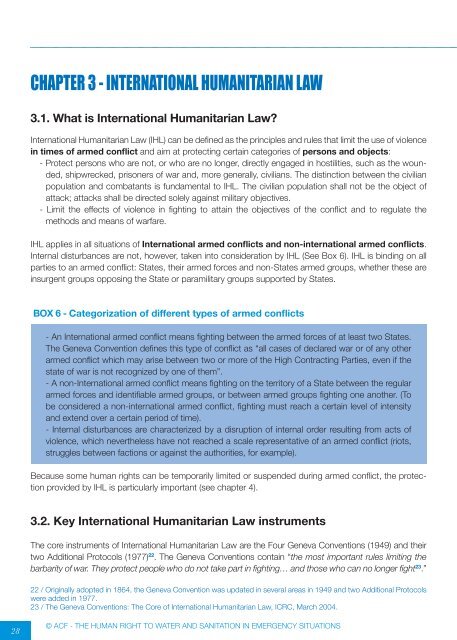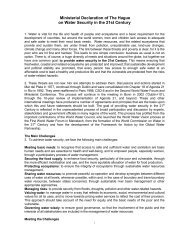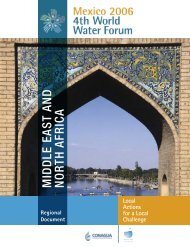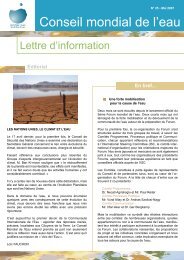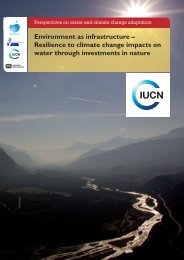the human right to water and sanitation in emergency situations
the human right to water and sanitation in emergency situations
the human right to water and sanitation in emergency situations
You also want an ePaper? Increase the reach of your titles
YUMPU automatically turns print PDFs into web optimized ePapers that Google loves.
28<br />
CHApTER 3 - INTERNATIONAl HUMANITARIAN lAW<br />
3.1. What is International Humanitarian Law?<br />
International Humanitarian Law (IHL) can be def<strong>in</strong>ed as <strong>the</strong> pr<strong>in</strong>ciples <strong>and</strong> rules that limit <strong>the</strong> use of violence<br />
<strong>in</strong> times of armed conflict <strong>and</strong> aim at protect<strong>in</strong>g certa<strong>in</strong> categories of persons <strong>and</strong> objects:<br />
- Protect persons who are not, or who are no longer, directly engaged <strong>in</strong> hostilities, such as <strong>the</strong> wounded,<br />
shipwrecked, prisoners of war <strong>and</strong>, more generally, civilians. The dist<strong>in</strong>ction between <strong>the</strong> civilian<br />
population <strong>and</strong> combatants is fundamental <strong>to</strong> IHL. The civilian population shall not be <strong>the</strong> object of<br />
attack; attacks shall be directed solely aga<strong>in</strong>st military objectives.<br />
- Limit <strong>the</strong> effects of violence <strong>in</strong> fight<strong>in</strong>g <strong>to</strong> atta<strong>in</strong> <strong>the</strong> objectives of <strong>the</strong> conflict <strong>and</strong> <strong>to</strong> regulate <strong>the</strong><br />
methods <strong>and</strong> means of warfare.<br />
IHL applies <strong>in</strong> all <strong>situations</strong> of International armed conflicts <strong>and</strong> non-<strong>in</strong>ternational armed conflicts.<br />
Internal disturbances are not, however, taken <strong>in</strong><strong>to</strong> consideration by IHL (See Box 6). IHL is b<strong>in</strong>d<strong>in</strong>g on all<br />
parties <strong>to</strong> an armed conflict: States, <strong>the</strong>ir armed forces <strong>and</strong> non-States armed groups, whe<strong>the</strong>r <strong>the</strong>se are<br />
<strong>in</strong>surgent groups oppos<strong>in</strong>g <strong>the</strong> State or paramilitary groups supported by States.<br />
BOX 6 - Categorization of different types of armed conflicts<br />
- An International armed conflict means fight<strong>in</strong>g between <strong>the</strong> armed forces of at least two States.<br />
The Geneva Convention def<strong>in</strong>es this type of conflict as “all cases of declared war or of any o<strong>the</strong>r<br />
armed conflict which may arise between two or more of <strong>the</strong> High Contract<strong>in</strong>g Parties, even if <strong>the</strong><br />
state of war is not recognized by one of <strong>the</strong>m”.<br />
- A non-International armed conflict means fight<strong>in</strong>g on <strong>the</strong> terri<strong>to</strong>ry of a State between <strong>the</strong> regular<br />
armed forces <strong>and</strong> identifiable armed groups, or between armed groups fight<strong>in</strong>g one ano<strong>the</strong>r. (To<br />
be considered a non-<strong>in</strong>ternational armed conflict, fight<strong>in</strong>g must reach a certa<strong>in</strong> level of <strong>in</strong>tensity<br />
<strong>and</strong> extend over a certa<strong>in</strong> period of time).<br />
- Internal disturbances are characterized by a disruption of <strong>in</strong>ternal order result<strong>in</strong>g from acts of<br />
violence, which never<strong>the</strong>less have not reached a scale representative of an armed conflict (riots,<br />
struggles between factions or aga<strong>in</strong>st <strong>the</strong> authorities, for example).<br />
Because some <strong>human</strong> <strong>right</strong>s can be temporarily limited or suspended dur<strong>in</strong>g armed conflict, <strong>the</strong> protection<br />
provided by IHL is particularly important (see chapter 4).<br />
3.2. Key International Humanitarian Law <strong>in</strong>struments<br />
The core <strong>in</strong>struments of International Humanitarian Law are <strong>the</strong> Four Geneva Conventions (1949) <strong>and</strong> <strong>the</strong>ir<br />
two Additional Pro<strong>to</strong>cols (1977) 22 . The Geneva Conventions conta<strong>in</strong> “<strong>the</strong> most important rules limit<strong>in</strong>g <strong>the</strong><br />
barbarity of war. They protect people who do not take part <strong>in</strong> fight<strong>in</strong>g… <strong>and</strong> those who can no longer fight 23 .”<br />
22 / Orig<strong>in</strong>ally adopted <strong>in</strong> 1864, <strong>the</strong> Geneva Convention was updated <strong>in</strong> several areas <strong>in</strong> 1949 <strong>and</strong> two Additional Pro<strong>to</strong>cols<br />
were added <strong>in</strong> 1977.<br />
23 / The Geneva Conventions: The Core of International Humanitarian Law, ICRC, March 2004.<br />
© ACF - THE HUMAN RIGHT TO WATER AND SANITATION IN EMERGENCY SITUATIONS


